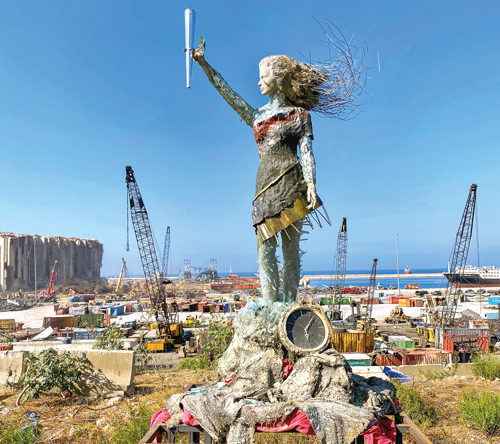|
|
|
Best Sculpture
|
|
Hayat Nazer
Hayat Nazer
|
|
 |
|
Hayat Min Damar. Upcycled mixed media, 260x200 cm |
|
|
At more than two and a half meters tall, the structure is a bold rendition of a woman, arm raised, hair swept by the wind, and face ruthlessly scarred, and therein lays the dichotomy between a vision of brutality and pain with that of resilience and faith. Next to her delicate feet is a broken clock, hands pointing to 6:08pm, forever frozen to the exact a moment of terrible impact when the devastating Port Explosion took place, changing people’s lives forever. “If you look at the statue, one half has a leg standing, the hand looks surrendered, there is a scar on the face with the flying hair and the clock on this side, as if the explosion is still happening,” Nazer explains. “But the other hand and the other leg is leaning as if it is starting to walk and the hand is raised, it wants to continue, it wants to keep going and rise from the rubble. And this is the truth, this is our truth,” she says.
Hayat has left a significant mark on the face of Lebanese street art with her most impactful work: ‘Hayat Min Damar’ (Hope after destruction), the sculpture is a symbol of hope in times of loss and turmoil. The glass, wood, metal, plastic and debris that make up the bulk of the female form were collected during the many cleanups that Hayat herself partook in, along with countless other Good (Lebanese) Samaritans. This is not new for Hayat as the artist has had a lot of experience converting debris into art: much of her street art involves taking whatever she can find and transforming them into something symbolically tethered to the items themselves. Perhaps the most tender aspect of the work is that much of the broken pieces were once part of the blast’s victims’ home: “I travelled to people’s homes after they were destroyed by the explosion and told them, ‘I just want you to give me anything I can include to make you a part of my sculpture,” Nazer said. “I was shocked. People gave me such valuable things — things from their childhood, their grandparents who died in the civil war, things they wanted to save for their children. So many emotions went into this.”
Hailing from Tripoli, Hayat Nazer (b. 1987) is a self-taught multidisciplinary artist. She is known mostly for her street art during the Lebanese revolution in 2019. |
|
|
|
|
|
|
|
|
© 2021 by InfoPro sal. All Rights Reserved
|
|
|
|